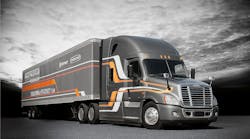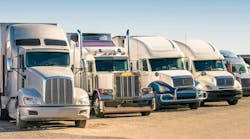Back in February, President Barack Obama publicly charged the Environmental Protection Agency (EPA) and the Dept. of Transportation’s National Highway Traffic Safety Administration (NHTSA) with “coming up with a proposal [notice of proposed rulemaking] by March of next year” for what will be required under Phase II of the greenhouse gas and fuel-efficiency (GHG/MPG) standards for medium- and heavy-duty trucks.
The resulting Phase II standards are seen as building on the first-ever standards for medium- and heavy-duty vehicles (model years 2014 through 2018). Thus, they will apply first to 2019 model-year vehicles.
According to the Obama Administration, the Phase II standards will be developed through partnering with various industry and public stakeholders “to develop standards that provide long-term certainty and promote innovation” and by “spurring manufacturing innovation [that will] lead to the adoption of new fuel-efficient technologies on trucks and semi-trailers.”
BUILDING A NATIONAL FLEET
In a nutshell, Phase II will hopefully result in still more fuel-saving equipment being built into trucks and, for the first time under the GHG/MPG rules, on trailers as well.
As for all the talk of partnering, the government’s stated goal is for EPA and NHTSA to work with such stakeholders as vehicle/equipment manufacturers, state agencies, labor organizations and non-governmental organizations “to explore further opportunities for fuel consumption and emissions reductions beyond the model-year 2018 timeframe.”
EPA and NHTSA have also been charged with working closely with the California Air Resources Board (CARB) to ensure the “next phase of standards allow manufacturers to continue to build a single national fleet.”
As for advancing both truck and trailer innovation, EPA and NHTSA are both going to “assess advanced technologies that may not currently be in production” and consider their potential to improve engine and powertrain efficiency, aerodynamics, weight reduction, tire rolling resistance, hybridization, automatic engine shutdown, and accessory efficiency (water pumps, fans, auxiliary power units, air conditioning, etc.).
That sums up what the federal government has said to date about Phase II. Other than noting the inclusion of new fuel-efficient technologies on semi-trailers, what’s been issued is more a policy position than an official roadmap to the shape of things to come.
CARB shed some additional light on what may be ahead during a public workshop held in March. The California state agency pointed out that while “Phase I was intended as a first step for [emissions] standards,” Phase II will implement “more stringent CO2 standards” for medium/heavy vehicles.
In addition, CARB advised that the “current analysis [of Phase II] is focusing on technology and cost feasibility for advanced strategies.” The agency also noted that a “full-rulemaking process is planned at both the federal agencies and separately at CARB” around Phase II.
A white paper released in March by the American Council for an Energy-Efficient Economy (ACEEE), a nonprofit think tank, compares four options for how the Phase II GHG/MPG rules may be laid out.
“Further major efficiency gains are possible in Phase II, including many from technologies already available or now being demonstrated,” stated the report’s authors, Siddiq Khan, senior researcher and leader of ACEEE’s heavy-duty vehicle program, and Therese Langer, the nonprofit’s transportation program director.
However, they contend that “the [Phase II] program’s ability to drive these gains will depend on its structure…” as “…certain features of the Phase I program limit its ability to draw technologies into the market.”
They relate that one such Phase I feature is “the separate standards for engines and vehicles, which effectively ignore potential efficiency gains from integrated engine/vehicle approaches.”
Thus, their paper addresses whether regulators should retain the Phase I structure in Phase II or switch to an approach that emphasizes full-vehicle standards.
The authors’ Option A would see the post-2018 rules following the structure of Phase I with separate engine and vehicle standards being developed. Their Option B would see Phase II migrating to an integrated, full-vehicle standard.
Khan and Langer also considered Option C, an extension of the Phase I structure that would replace engine standards with those for the engine plus the transmission. And they looked as well at Option D, a combination of Options A and B.
SETTING WORKABLE STANDARDS
“All of these options involve substantial and unresolved issues, and additional technical information will be required to determine how and if they can be resolved,” the authors advised.
However, their analysis found that Option D—separate engine and full-vehicle standards—“looks the most promising” approach for Phase II.
“The primary purpose of the standards is to derive efficiency technologies for heavy-duty vehicles, and Option D’s superior performance on that criterion must be given extra weight,” Khan and Langer argued.
They noted that Option D “also does as well as any in its ability to reflect real-world performance, another key criterion.”
On the other hand, the authors state that while the “remaining criteria are important and could even pose insuperable obstacles to Option D and to some of the other options, the issues they raise are largely technical rather than fundamental, so it may be possible to solve them.”
Khan and Langer make a strong case for Phase II standards being applied to the vehicle as a whole. Therefore, they contend that by following such an approach, “the certified fuel consumption and emissions of the [full] vehicle would reflect the specifications and/or performance of the engine and transmission sold with the vehicle.”
The upshot, then, would be that “certified fuel efficiency [for the Phase II standards] would generally be a reasonable approximation to actual vehicle performance over the test cycle and with the test load.”
There appears to be a dearth of research out so far on just what shape will be taken by the “advanced technologies that may not currently be in production” that EPA and NHTSA are to assess for Phase II.
Yet a global environmental think tank early this year released a research paper on the inclusion of semi-trailers in the Phase II GHG/MPG rules.
The paper, lengthily entitled “Recommendations for Regulatory Design, Testing, and Certification for Integrating Trailers into the Phase II U.S. Heavy-Duty Vehicle Fuel Efficiency and Greenhouse Gas Regulation,” sums up recent research on the topic by the nonprofit International Council on Clean Transportation (ICCT).
“The guiding principle in this analysis is that the classification framework, as well as the testing and certification procedures, for trailers should be as closely aligned to that of tractors as possible,” stated the paper’s author Ben Sharpe, senior researcher with ICCT’s heavy-duty vehicle program.
The author noted that “early voluntary efforts” resulting from EPA’s SmartWay program and CARB’s tractor-trailer GHG rule “succeeded in driving trailer technology development, technology cost reductions, and increasing adoption of trailer technology.”
That being said, Sharpe contended the approach ICCT prescribes for trailer technologies in Phase II “offers a natural extension of the same policy principles [of Phase I], but with wider fleet fuel savings and carbon emission benefits” that will result once the new rules are implemented beyond 2018.
In his paper, Sharpe makes these specific points regarding how to tackle the regulation of trailer technologies within Phase II:
- Integrate trailers into the Phase II U.S. heavy-duty vehicle regulatory program to greatly increase the fuel and GHG reductions of the program.
- Approximate potential benefits from trailers are 7% to 10% per tractor-trailer, as compared with the 17% to 23% per tractor from the Phase 1 program that excludes trailers.
- Make trailer manufacturers a “directly regulated entity” within the heavy-vehicle regulatory program “for increased certainty that fuel-saving trailer technologies will be adopted and to provide regulatory clarity.”
- Develop trailer-classification framework that facilitates improvements in aerodynamics, tire rolling resistance and “lightweighting” for van trailers as well as improvements in tire rolling resistance for all trailer types.
- Align testing and certification procedures for tractors and trailers as much as possible.
- For trailer aerodynamic testing, “pursue an A-to-B approach in which an identical tractor is used to test both a baseline and an ‘enhanced’ trailer” to certify the enhanced model’s “aerodynamic bin level.”
- Use a grams/ton-mile (and functionally equivalent gallons/ton-mile) certification metric for trailers that is identical to the metric used for tractors and vocational vehicles in Phase I.
According to Sharpe, ICCT’s trailer-related recommendations “point toward a Phase II heavy-duty regulatory program that more comprehensively promotes known cost-effective technologies for tractor-trailers.”



